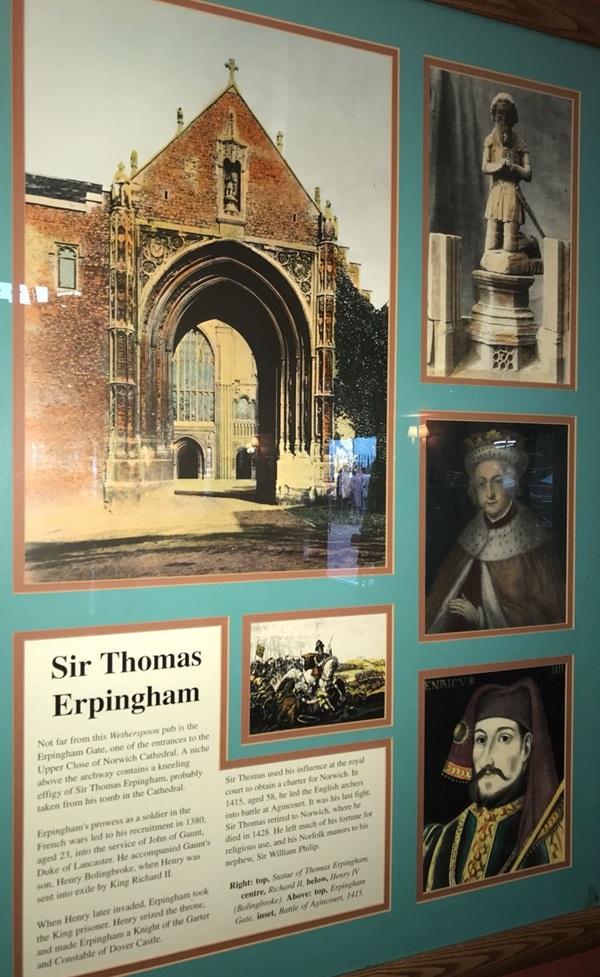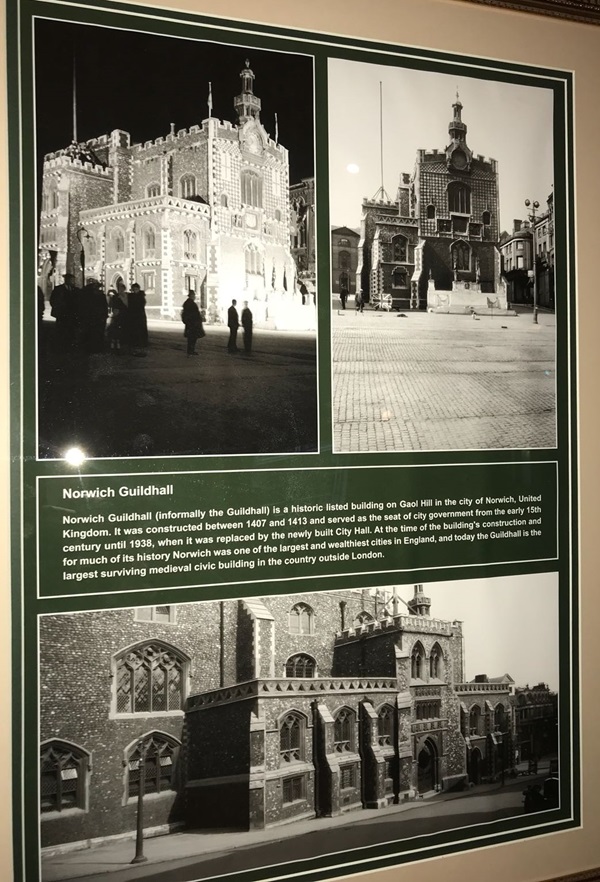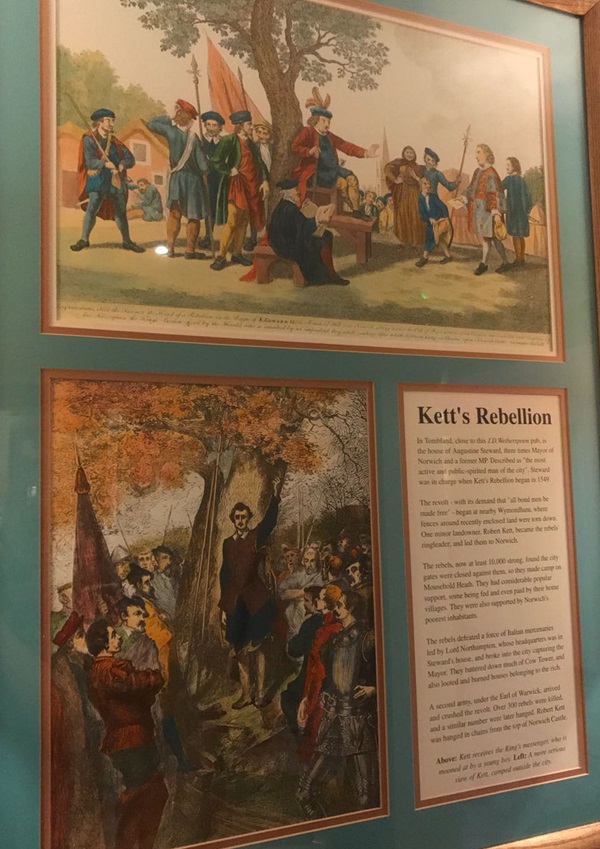Numbers 11–13 Wensum Street were previously in use as small shops and The Glass House Restaurant, the latter recalling the glass company which had been on this site for several decades.
A photograph and text about The Glass House.

The text reads: Numbers 11-13 Wensum Street were previously in use as small shops before renovated into The Glass House. The Glass House owes its name to both the glass company which had been on this site for several decades and Norwich’s long history with glass. The Norwich School of glass makers was a mediaeval Norwich-based community of stained glass markers, mostly active between the mid-14th century and the English Reformation, when much of the glass was destroyed as part of the general injunction against stained glass, shrines, roods, statues and bells. The school’s generally light and uncomplicated style has stylised methods of depicting floors and countryside, including motifs resembling ears of barley, seaweed, chequers or pebbles. In common with other church craftsmen, the glass painters used a characteristic border design which resembled a holly leaf wrapped around a rod, as seen at the top of the pub fronts ionic pillars. (Photograph courtesy of George Plunkett).
Prints and text about Sir Thomas Erpingham.

The text reads: Not far from this Wetherspoon pub is the Erpingham Gate, one of the entrances to the Upper Close of Norwich Cathedral. A niche above the archway contains a kneeling effigy of Sir Thomas. Erpingham, probably taken from his tomb in the Cathedral.
Empingham’s prowess as a soldier in the French wars led to his recruitment in 1380, aged 23, into the service of John of Gaunt, Duke of Lancaster. He accompanied Gaunt’s son, Henry Bolingbroke, when Henry was sent into exile by King Richard II.
When Henry later invaded, Erpingham took the King prisoner, Henry seized the throne and made Erpingham a Knight of the Garter and Constable of Dover Castle.
Sir Thomas used his influence at the royal court to obtain a charter for Norwich. In 1415, aged 58, he led the English archers into battle at Agincourt. It was his last fight. Sir Thomas retired to Norwich, where he died in 1428. He left much of his fortune for religious use, and his Norfolk manors to his nephew, Sir William Philip.
Right: top, Statue of Thomas Erpingham, centre, Richard II, below, Henry IV (Bolingbroke)
Above: top, Erpingham Gate, inset, Battle of Agincourt, 1415.
Photographs and text about Norwich Guildhall.

The text reads: Norwich Guildhall (informally the Guildhall) is a historic listed building on Gaol Hill in the city of Norwich, United Kingdom. It was constructed between 1407 and 1413 and served as the seat of city government from the early 15h century until 1938 when it was replaced by the newly built City Hall. At the time of the building’s construction and for much of its history Norwich was one of the largest and wealthiest cities in England, and today the Guildhall is the largest surviving medieval civic building in the country outside London.
Photographs and text about Baedeker Raids.

The text reads: On April 27, 1942, the residents of Norwich woke up in the middle of the night to the sound of sirens and the menacing hum of incoming aircraft. It marked the start of the first Luftwaffe raid of Norwich, part of the Baedeker raids that also occurred over Canterbury, Bath, Exeter, and York. The raids got their name from the Baedeker guidebooks which noted that these cities were of great cultural and historical importance. It is commonly that it was from these guides that the Germans decided which cities to strike.
During two nights of intense bombing, the cathedral city suffered its worst ordeal of the war. The majority of the city’s most historical buildings, including its Norman castle and cathedral, escaped the bombs and fires that ravaged so many shops, factories and homes. But the raids came with a heavy cost, killing more than 200, injuring many more and thousands of residents seeing their homes destroyed.
Prints and text about Kett’s Rebellion.

The text reads: In Tombland, close to this JD Wetherspoon pub, is the house of Augustine Steward, three Mayor of Norwich and a former MP. Described as “the most active and public-spirited man of the city”. Steward was in charge when Kett’s Rebellion began in 1549.
The revolt – with its demand that “all bond men be made free” – began at nearby Wymondham, where fences around recently enclosed land were torn down. One minor landowner, Robert Kett, became the rebels’ ringleader, and led them to Norwich.
The rebels, now at least 10,000 strong, found the city gates were closed against them, so they made camp on Mousehold Heath. They had considerable popular support, some being fed and even paid by their home villages. They were also supported by Norwich’s poorest inhabitants.
The rebels defeated a force of Italian mercenaries led by Lord Northampton, whose headquarters was in Steward’s house, and broke into the city capturing the Mayor. They battered down much of Cow Tower, and also looked and burned houses belonging to the rich.
A second army, under the Earl of Warwick, arrived and crushed the revolt. Over 300 rebels were killed, and a similar number were later hanged. Robert Kett was hanged in claims from the top of Norwich Castle.
External photograph of the building – main entrance.

If you have information on the history of this pub, then we’d like you to share it with us. Please e-mail all information to: pubhistories@jdwetherspoon.co.uk